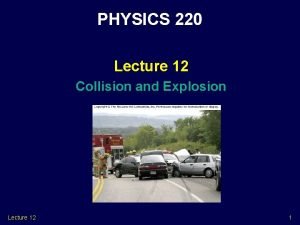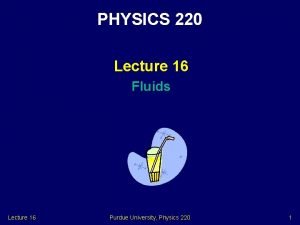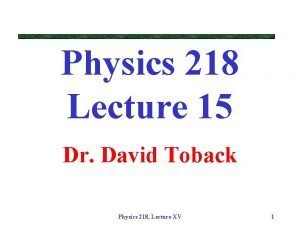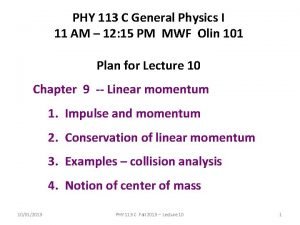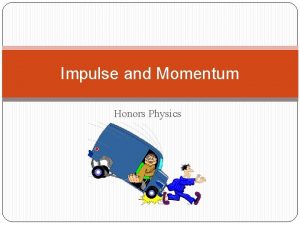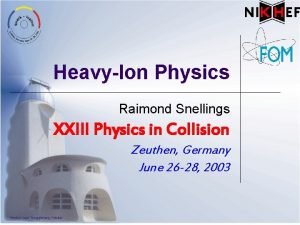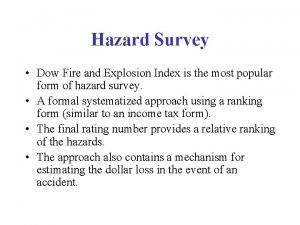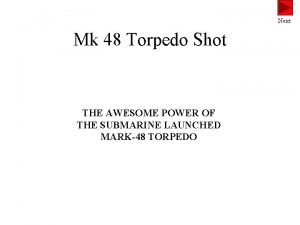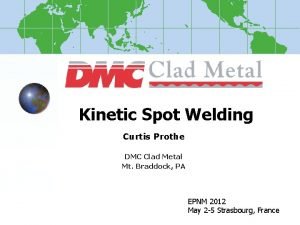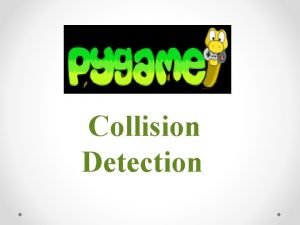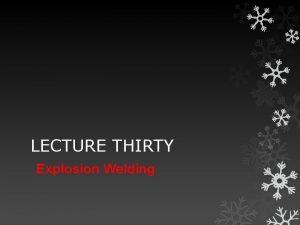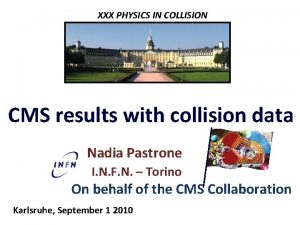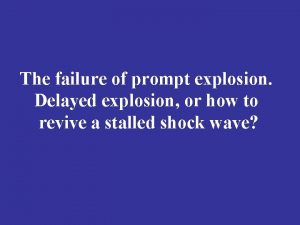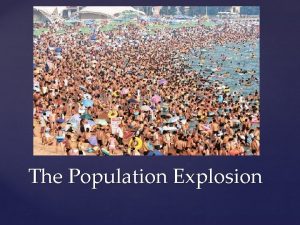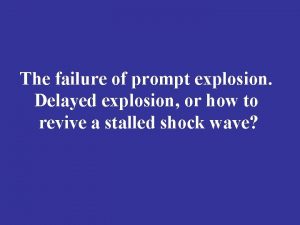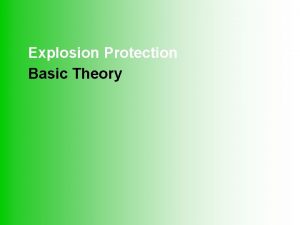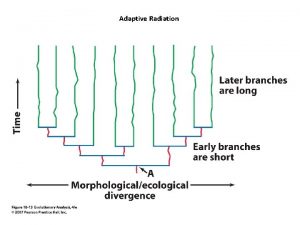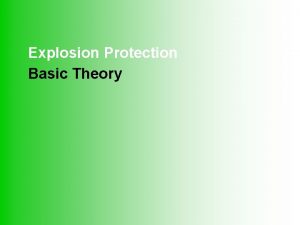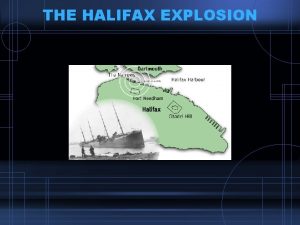PHYSICS 220 Lecture 12 Collision and Explosion Lecture




















- Slides: 20

PHYSICS 220 Lecture 12 Collision and Explosion Lecture 12 1

Example • A freight train is being assembled in switching yard. Car 1 has a mass of m 1=65 103 kg and moves at a velocity v 01=0. 80 m/s. Car 2 has a mass of m 2=92 103 kg and moves at a velocity v 02=1. 3 m/s and couples to Car 1. Neglecting friction, find the common velocity vf of the cars after they become coupled. m 2 Lecture 12 v 02 m 1 vf v 01 initial final 2

Example • A fright train is being assembled in switching yard. Car 1 has a mass of m 1=65 103 kg and moves at a velocity v 01=0. 80 m/s. Car 2 has a mass of m 2=92 103 kg and moves at a velocity v 02=1. 3 m/s and couples to it. Neglecting friction, find the common velocity vf of the cars after they become coupled. Apply conservation of momentum: Pi=m 1 vo 1+m 2 v 02 Pf=(m 1+m 2)vf = m 1 v 01+m 2 v 02 Lecture 12 3

Center of Mass L Example 1: m m x. CM = (0 + m. L)/2 m = L/2 L Example 2: Lecture 12 m 5 m X=0 X=L x. CM = (0 + 5 m. L)/6 m = 5 L/6 4

Center of Mass • For symmetric objects that have uniform density the CM will simply be at the geometrical center! + CM + Lecture 12 + + 5

Exercise • The disk shown below (1) clearly has its CM at the center. • Suppose the disk is cut in half and the pieces arranged as shown in (2): Where is the CM of (2) as compared to (1)? A) higher B) lower C) same X CM Lecture 12 (1) (2) 6

Exercise • The CM of each half-disk will be closer to the fat end than to the thin end (think of where it would balance). l The CM of the compound object will be halfway between the CMs of the two halves. l This is higher than the CM of the disk X X CM (1) Lecture 12 X X (2) 7

Dynamics of Many Particles ptot = mtot. Vcm Fext. Dt = Dptot = mtot. DVcm or Fext = mtotacm So if Fext = 0 then Vcm is constant • Center of Mass of a system behaves in a SIMPLE way - moves like a point particle! - velocity of CM is unaffected by collision if Fext = 0 Lecture 12 8

Astronauts & Rope • Two astronauts at rest in outer space are connected by a light rope. They are at a distance L and they begin to pull towards each other. Where do they meet? A) L/2 B) 2 L/5 C) 1/5 L m M = 1. 5 m L Lecture 12 9

Astronauts & Rope. . . l l They start at rest, so VCM = 0. VCM remains zero because there are no external forces. So, the CM does not move! They will meet at the CM. m M = 1. 5 m CM L x=0 x=L Finding the CM: If we take the astronaut on the left to be at x = 0: Lecture 12 10

Explosion How much further does the stage go? Lecture 12 11

Explosion Example: m 1 = M/3 m 2 = 2 M/3 v 1 “before” M m 1 m 2 v 2 “after” • Which block has larger |momentum|? * Each has same |momentum| • Which block has larger speed? * mv same for each smaller mass has larger velocity • Which block has larger kinetic energy? * K = mv 2/2 = m 2 v 2/2 m = p 2/2 m * smaller mass has larger kinetic energy • Is mechanical (kinetic) energy conserved? * NO Lecture 12 12

Explosion and Collision Explosion M m 1 m 2 Procedure “before” • Draw “before” and “after” • Define system so that Fext = 0 • Set up a coordinate system Collision m 1 Lecture 12 m 2 “before” “after” • Compute ptotal “before” • Compute ptotal “after” • Set them equal to each other 13

Type of Collision • Elastic Collisions: – collisions that conserve mechanical energy • Inelastic Collisions: – collisions that do not conserve mechanical energy • Completely Inelastic Collisions: – objects stick together Elastic Lecture 12 Inelastic Completely Inelastic 14

2 -D Problems y x before after • Ptotal, x and Ptotal, y independently conserved Ptotal, x, before = Ptotal, x, after Ptotal, y, before = Ptotal, y, after Lecture 12 15

Elastic Collision • Assuming – Collision is elastic (KE is conserved) – Balls have the same mass – One ball starts out at rest pf pi vcm Pf F before Lecture 12 after 16

Playing Pool • According to what you have learned so far, you would want think twice before attempting the shot because … Lecture 12 17

• Conservation of momentum vc, f 900 Vp, f vc, i • Conservation of energy Lecture 12 18

Completely Inelastic Collision y m 1 x v 1 v 2 m 2 • Find vf and Lecture 12 before m 1+m 2 vf after 19

Completely Inelastic Collision in Two Dimensions x • Find vf and y Lecture 12 m 1+m 2 vf after 20
 Explosion collision physics
Explosion collision physics Physics 220 purdue
Physics 220 purdue Collision physics
Collision physics Fall 2013
Fall 2013 Impulse and momentum
Impulse and momentum Collision physics
Collision physics 01:640:244 lecture notes - lecture 15: plat, idah, farad
01:640:244 lecture notes - lecture 15: plat, idah, farad F&ei
F&ei Physics 111 lecture notes
Physics 111 lecture notes Physics 101 lecture notes pdf
Physics 101 lecture notes pdf Physics 101 lecture 1
Physics 101 lecture 1 Physics 101 lecture notes pdf
Physics 101 lecture notes pdf Physics notes pdf
Physics notes pdf Atmospheric physics lecture notes
Atmospheric physics lecture notes The explosion poem
The explosion poem Superman's other identity
Superman's other identity Evangelism explosion outline
Evangelism explosion outline Population explosion definition
Population explosion definition Mark 48 torpedo
Mark 48 torpedo Tug of war visible thinking
Tug of war visible thinking Dmc cladding
Dmc cladding
